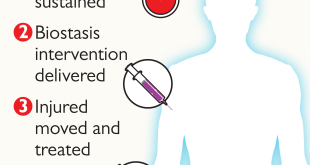Some 1 million people suffer traumatic brain injuries annually. Concussion can cause inner ear damage that can cause dizziness, anxiety, depression, moodiness, balance problems and irritability, said Elizabeth Kirkpatrick, the physical therapist for the Fort Drum Traumatic Brain Injury Clinic. The three different forms of TBI—severe, moderate, and mild—all manifest in different ways ranging from memory loss and extended unconsciousness to a simple headache. Mild TBI tends to go unnoticed. In the most severe cases, internal bleeding increases pressure on the brain, which chokes off blood circulation and can be debilitating or fatal. The cost of treating traumatic brain injury (TBI) is estimated to run into billions of dollars in the future.
Military personnel face a high risk of traumatic brain injury (TBI), resulting in debilitating long-term burden that impacts not only the warfighter but also families, friends and the healthcare infrastructure. Current interventions rely solely on physical protection measures, such as armored vehicles and bulky helmets and treatments are limited to physical and/or psychological rehabilitation protocols with limited success.
DARPA is looking to save its warfighters from the crippling and cascading effects of a head injury. In June 2022, DARPA launched the Cornerstone program that aims to develop safe and effective integrated countermeasures to prevent brain injury.
When an individual sustains a brain injury, it triggers a complex cascade of events that resemble a domino effect. This starts within milliseconds of exposure with an initial response at the cellular or molecular level, followed by an exponentially expanding set of separate, different, and parallel molecular events that can continue for weeks or months, with each path requiring separate treatment. Cornerstone aims to target the initial response milliseconds after injury, thereby mitigating the need to treat multiple targets simultaneously.
Program proposers are encouraged to combine exposure models (to blast and impact) with emerging neuroscience research tools that have enabled real-time measurement and visualization of molecular and cellular responses in vitro, ex vivo, and in vivo. Methods that allow for the observation of potentially responsive receptors and channels to a variety of energetic stimuli, on the microsecond or millisecond time-scale, would be valuable in validating potential prophylactic countermeasure strategies. Cornerstone performers will successfully pair these highly time-resolved observation capabilities with energetic exposure models as part of a comprehensive countermeasure validation strategy.
“At this time, no treatments for TBI have progressed past Phase II clinical trials because they focus on providing a post-exposure countermeasure,” said Dr. Eric Van Gieson, Cornerstone program manager. “Cornerstone aims to improve mission execution and warfighter protection by reorienting the research community to stop what happens at a molecular level in the first few seconds of exposure to blast or impact. Through this lens, Cornerstone performers will focus on building safe and effective integrated countermeasures–preventing TBI from happening at all.”
The five-year fundamental research effort involves two technical areas (TAs) in three phases aimed at developing preventative countermeasures to TBI.
TA1 will identify and validate countermeasures that prevent relevant targets from initiating harmful downstream signaling injury response(s) to a blast (e.g. kinetic) injury.
TA2 will develop clinically relevant spatial and temporal delivery of countermeasures that prevent molecular targets from responding to kinetic insult at sites of injury. The goal is that upon program completion, performers will have developed safe, effective integrated countermeasures that allow for repeat prophylactic administration, and provide protection in response to injury. Upon kinetic injury, integrated countermeasures should demonstrate spatial and temporal bioactivity, inhibit the initiation of injury processes, and protect against the development of behavioral and cognitive effects associated with TBI.
According to the program description, Cornerstone research will be focused on the following areas:
- Identification, optimization, and validation of prophylactic countermeasures that prevent energetically responsive receptors (i.e., targets) from initiating injury response(s) to kinetic insult(s) inclusive of blast or impact
- Development of Integrated Countermeasures with precise delivery (i.e., spatial and temporal control)
The Pentagon’s research funding arm adds that “Proposed approaches should investigate the prevention of the initiation of harmful signaling cascades at sites of injury, for example, in the central and/or peripheral nervous systems (CNS, PNS) and/or vasculature, and develop countermeasures that can be administered prophylactically (i.e., before exposure) to prevent behavioral or cognitive deficit from TBI.”
Specifically excluded is research that involves:
- Genetic manipulation of the host in order to aid target engagement or achieve altered
downstream signaling as a countermeasure. - Sole use of in vitro or in vivo model systems that are not accepted as representative of
kinetic (e.g., blast or impact) injury modes. - Treatment strategies focused on interventions delivered beyond five seconds post-injury,
with preference for pretreatment-based countermeasures that provide a prophylactic
effect. - Reliance on invasive medical procedures for Integrated Countermeasure delivery (i.e.,
pumps, implants, lumbar or cranial injections). - Remotely triggered Integrated Countermeasure delivery (i.e., strategies that require user
or medic administration post-injury). - Approaches not inclusive of real-time and/or highly resolved temporal and spatial
techniques to validate targeting, safety, and efficacy of countermeasures.
References and Resources also include:
https://sociable.co/military-technology/darpa-cornerstone-behavioral-cognitive-damage/
 International Defense Security & Technology Your trusted Source for News, Research and Analysis
International Defense Security & Technology Your trusted Source for News, Research and Analysis

